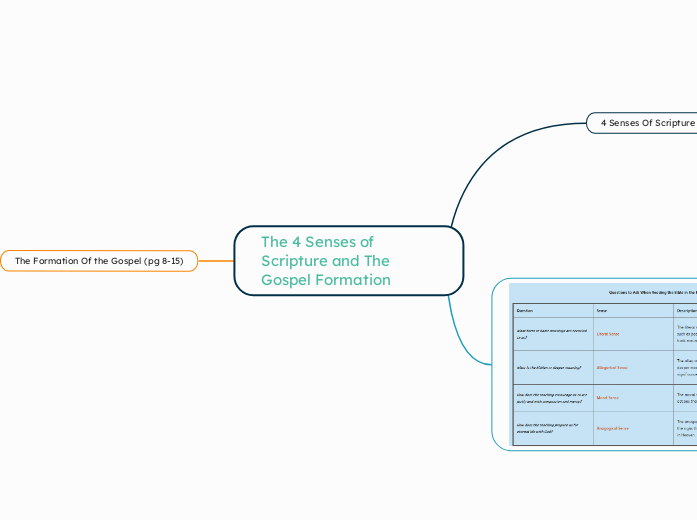The 4 Senses of Scripture and The Gospel Formation
4 Senses Of Scripture (pg 21-25)
Literal Sense
The literal sense helps us discover facts, such as people and events, and basic meanings.
Spiritual Sense
When we pray, study, and reflect on a scripture passage, its words and details can often reveal deeper meanings, which can help us discern God’s saving truths. This is called reading in the spiritual sense.
Allegorical Sense
Reading Scripture in the allegorical sense involves looking for deeper meanings that help us understand the significance of the details. It helps us recognize how the passage contributes to our relationship with God and our salvation through Jesus.
Moral Sense
Our morals and beliefs about what is right and wrong. They influence the way we think and act.
The Formation Of the Gospel (pg 8-15)
3 Stages of the Gospel
Stage: 1 The life and teachings of Jesus
Jesus’ Baptism: Jesus began His mission after the Father and the Holy Spirit made their presence known at His Baptism. Jesus dedicated Himself to spreading the message of God’s love, mercy, and eternal salvation.
Jesus’ Ministry: Sent by the Father, Jesus and the Holy Spirit continued the mission of the Trinity to bring justice to the world. Jesus called the 12 Apostles and they travelled with Him, learning from Him as He spread His message.
The Birth Of The Church: Jesus had empowered Peter to open the door of faith, so that everyone might learn Jesus’ teachings and enter the kingdom of Heaven. Jesus promised Peter the keys to the Church.
Stage 2: The Oral Tradition
Preaching and Proclaiming the Good News: Many cultures relied on oral tradition to preserve their histories, and people were well practised at recalling events and passing down stories by word of mouth, The Apostles memorized the accounts of people who witnessed Jesus’ life and ministry so they could accurately repeat Jesus’ teachings
The Early Liturgies: When Jesus said "Do this in meomry of me" it led to the celebration of the first Eucharistic liturgies. These early liturgies were celebrated for several decades before the Gospels were written.
Stage 3: The Written Gospels
Although there were other written accounts, four accounts—the Gospels attributed to Matthew, Mark, Luke, and John—were seen as divinely inspired and authoritative; they became part of the New Testament.
Luke: Luke wasn’t one of the original 12 Apostles. He was a Greek physician who became a faithful believer in Jesus. Luke's gospel was intended to show them how they, too, could find the truth in the words of Jesus and enter God’s kingdom.
Mark: Mark was one of Peter’s friends Mark’s Gospel was completed around 70 ad. It was written for early Christians in Rome who were being persecuted for following Jesus.
Matthew: Matthew was a tax collector. When Matthew was at the tax booth Jesus walked past him and Matthew became one of the original 12 disciples. Matthew’s Gospel was completed around 80 AD. It was written for a Jewish audience.
John: John was a disciple of John the Baptist and was present when John the Baptist pointed at Jesus, identifying Him as the Lamb of God. John’s Gospel was completed around 90 ad. It recorded many of Jesus’ miracles to reveal Him as the true Messiah, the Son of God who came to give us eternal life.
